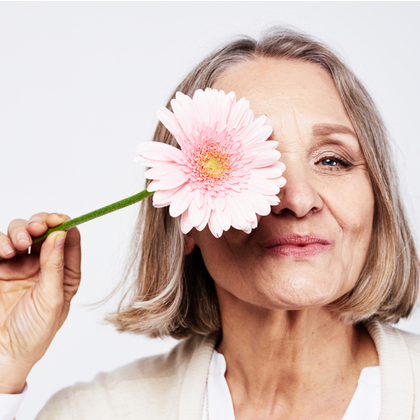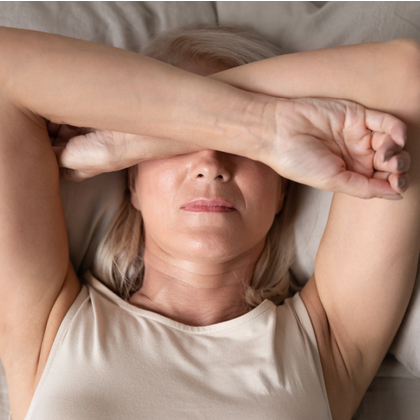
As you move towards the menopause, your body begins to show visible signs of declining oestrogen, in everything from hot flushes to night sweats. One lesser-known effect of menopause is the impact it can have on your bone health. While this symptom may be less visible, it can still take a toll on your body, even leading to more serious bone conditions, like osteoporosis (1).
To help you understand this link a little better, we explore the impact of the menopause on your bones and explain what you can do to keep them as healthy as possible.
How does the menopause impact bone health?
Throughout your life as a woman, oestrogen plays a critical role in regulating bone production and turnover. Every day, your bones perform a process of formation and breakdown. However, as you enter perimenopause, levels of oestrogen start to decline in the body sharply. As such, bone breakdown begins to exceed bone formation, which can result in weak and brittle bones. Research reports that women may lose up to 20% of their bone density in the five to seven years after the menopause (2).
How does menopause impact bone health?
Throughout your life as a woman, oestrogen plays a critical role in regulating bone production and turnover. Every day, your bones perform a process of formation and breakdown. However, as you enter perimenopause, levels of oestrogen start to decline sharply in the body. As such, bone breakdown begins to exceed bone formation, which can result in weak and brittle bones. Research reports that women may lose up to 20% of their bone density in the five to seven years after the menopause (2).
What is menopausal osteoporosis?
Osteoporosis is a condition that weakens bones and makes breakages more likely (3). When you have brittle bones, you can no longer rely on your skeleton to weather even routine movement; a bend, twist, or unexpected sneeze can fracture a fragile bone. Osteoporosis is often called the ‘silent disease’ because it’s usually symptomless and painless until a bone breaks. Sadly, once you break a bone, you are at a high risk of experiencing another.?
Due to the sharp decline in the bone-protective hormone, oestrogen, the chances of developing osteoporosis increase as you reach menopause and post menopause. So, the greater your bone density when you enter into the menopause, the lower your risk of developing osteoporosis at this stage.
How can I prevent osteoporosis during the menopause?
While you can’t stop age-related bone loss entirely, there’s still plenty you can do to prevent osteoporosis from occurring in the menopause and years after.
Try weight-bearing exercise
It’s vitally important to move as much as possible throughout menopause. Maintaining a regular exercise regime helps to sustain bone mass and muscle strength. On account of it stimulating extra calcium deposits and driving bone-forming cells (osteoblasts) into action, weight-bearing exercise is especially fortifying for bones. The pushing and tugging that occurs in this activity result in healthier, denser bones.
In one study on postmenopausal women, researchers found a 12-week weight-bearing exercise regime increased participants’ bone size, bone density, and bone strength (4). Walking, jogging, dancing, or higher-impact sports, like tennis, football or squash, are excellent examples of weight-bearing exercise.
Even if you have osteoporosis, you shouldn’t let the fear of fractures keep you from staying active. Movement and just being in nature are known to help manage ongoing discomfort, too, so consider exercising in your garden or a local park.
To protect your bones and prevent breakages, refrain from doing high-impact activities, like running and jumping, or activities that involve bending and twisting, such as some yoga poses, bowling, and golf. Of course, there are some caveats when exercising, so always speak to your doctor before trying anything too strenuous.
You can read more about the importance of movement for ongoing physical discomfort here.
Drink moderately
Drinking to excess can be problematic for bones. Heavy drinking interferes with the delicate balance of calcium in the body, which is essential for bones. Excessive alcohol consumption also affects the production of vitamin D – another vital nutrient for bone health. Researchers found that postmenopausal women who consumed more than six alcoholic drinks per day experienced higher bone loss than their female counterparts who drank minimally (5).
NHS guidelines advise against drinking more than 14 units a week (1 unit equals one 25ml single measure of whisky, a third of a pint of beer, or half a standard (175ml) glass of red wine) (6). If you’re drinking habitually, try to spread your intake over three or more days. Remember, you should have several drink-free days a week, too.
Go easy on the salt shaker
Aside from affecting your cardiovascular health, sodium plays a key role in regulating the amount of calcium in the urine. And since calcium is critical for bone strength, consuming too much sodium may lead to bone demineralisation, which increases the risk of osteoporosis. Since salt, also known as sodium chloride, is about 40% sodium, try to keep your salt intake below the recommended maximum of 6g a day. Making simple changes to your diet can help you achieve this, such as eating fewer ultra-processed treats and cooking with real, whole foods.
Quit smoking
Quitting smoking is one of the best things you can do for your bone health. Smoking produces vast amounts of free radicals (unstable atoms that damage cells in the body) that target cells involved in bone health. This habit also harms your blood vessels, leading to an inadequate blood supply of oxygen and making it harder for the body to heal fractures when they occur. Plus, both free radicals and nicotine negatively affect your bone-making cells, osteoblasts.
Hormone Replacement Therapy (HRT)
Hormone Replacement Therapy (HRT) is also widely used to protect bone health and prevent fractures throughout menopause. As we’ve already outlined, oestrogen deficiency is a major contributing factor in the development of osteoporosis. HRT fortifies bones by increasing your levels of oestrogen; it helps to normalise bone turnover, preserve bone mineral density, and reduce the risk of fractures (7).?
However, while HRT is beneficial for most women, it may not be suitable for everyone due to previous medical history or personal preference. Always speak to your GP to see if HRT is an appropriate fit. It’s worth mentioning that HRT is only ever a temporary intervention, too. Learn how to come off HRT safely here.
Try supplementation
The following supplements may support bone health as you transition through menopause.
Calcium
Calcium is widely touted for supporting normal bone health. Consider a specially formulated bone health multivitamin or mineral that delivers around 200-500mg of calcium.
Vitamin D
Given that vitamin D is essential for calcium absorption, it makes sense to keep an eye on your vitamin D intake. Generally, those with lower bone density are more prone to fractures.8 To support your bone health, especially after the menopause, aim for 25µg of the sunshine nutrient daily. Learn more about managing osteoporosis in menopause with vitamin D in our guide.
Magnesium
Aiding the proper absorption of calcium and converting vitamin D into its active form, magnesium is one of the most vital nutrients for your bones. Look for a multivitamin that supplies approximately 250mg of magnesium.
Vitamin K
It’s well documented that vitamin K2 helps the body properly utilise calcium. Without sufficient vitamin K2, calcium isn’t bound to the bone matrix, but free to be deposited in blood vessels, which could be potentially harmful to your bone and heart health. If you’re considering vitamin K supplementation, choose a bone health multivitamin that delivers around 90µg.
Soy isoflavones
Some evidence suggests soya may play a role in bone health.9 If you aren’t a fan of soy-based foods (such as tofu or some meat-alternatives), then consider adding soya isoflavones to your diet.
PEA
PEA is an endocannabinoid-like compound found in almost every cell, tissue, and fluid in the body. Naturally produced when cells are damaged or threatened, PEA is a well-researched alternative to CBD and an increasingly popular choice to manage physical discomfort.
More on the menopause
Discover even more menopause health advice on our Menopause hub.
References:
-
Ji. M.X., Yu Q., Primary osteoporosis in postmenopausal women. Chronic diseases and translational medicine. 2015;1(1):9-13.
-
nhs.uk. (2020). Menopause and your bone health. Available online: https://www.nhs.uk/live-well/healthy-body/menopause-and-your-bone-health/
-
nhs.uk. (2020). Osteoporosis. Available online: https://www.nhs.uk/conditions/osteoporosis/
-
Klentrou P. et al., Effects of Exercise Training with Weighted Vests on Bone Turnover and Isokinetic Strength in Postmenopausal Women. Journal of Aging and Physical Activity. 2007;15(3):287-299.
-
nhs.uk. 2020. Alcohol Units. Available online: https://www.nhs.uk/live-well/alcohol-support/calculating-alcohol-units/
-
Hannan M. et al., Risk Factors for Longitudinal Bone Loss in Elderly Men and Women: The Framingham Osteoporosis Study. Journal of Bone and Mineral Research. 2010;15(4):710-720.
-
Gambacciani. M., Levancini M., Hormone replacement therapy and the prevention of postmenopausal osteoporosis. Przeglad menopauzalny = Menopause review. 2014;13(4):213-220.
-
Bener. A., Saleh N., Low vitamin D, and bone mineral density with depressive symptoms burden in menopausal and postmenopausal women. Journal of Mid-life Health. 2015;6(3):108.
-
Ma D. et al., Soy isoflavone intake increases bone mineral density in the spine of menopausal women: Meta-analysis of randomized controlled trials. Clinical Nutrition. 2008;27(1):57-64.
Disclaimer: The information presented by Nature's Best is for informational purposes only. It is based on scientific studies (human, animal, or in vitro), clinical experience, or traditional usage as cited in each article. The results reported may not necessarily occur in all individuals. Self-treatment is not recommended for life-threatening conditions that require medical treatment under a doctor's care. For many of the conditions discussed, treatment with prescription or over the counter medication is also available. Consult your doctor, practitioner, and/or pharmacist for any health problem and before using any supplements or before making any changes in prescribed medications.
Related Posts

Olivia
Olivia Salter has always been an avid health nut. After graduating from the University of Bristol, she began working for a nutritional consultancy where she discovered her passion for all things wellness-related. There, she executed much of the company’s content marketing strategy and found her niche in health writing, publishing articles in Women’s Health, Mind Body Green, Thrive and Psychologies.
View More



